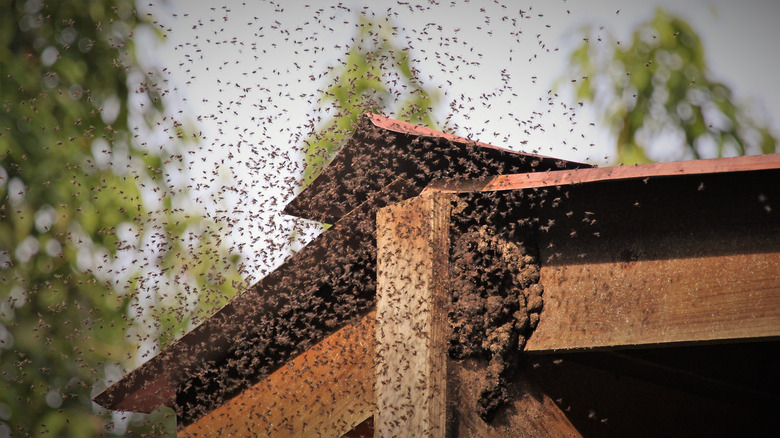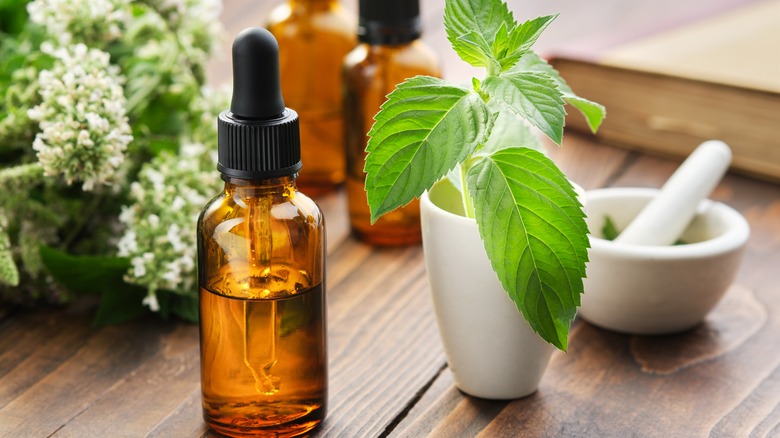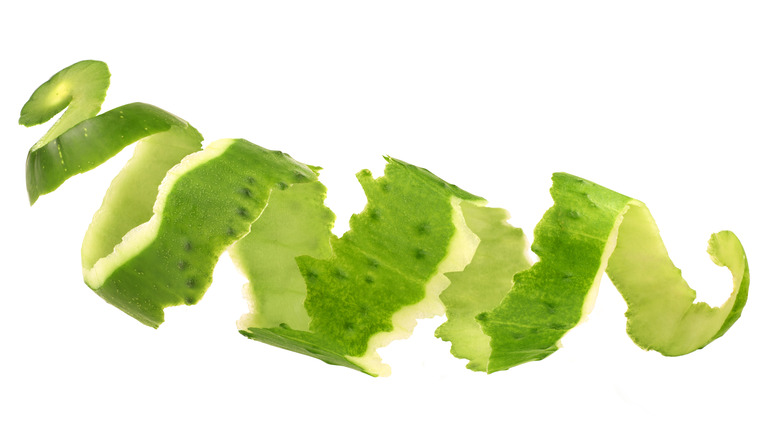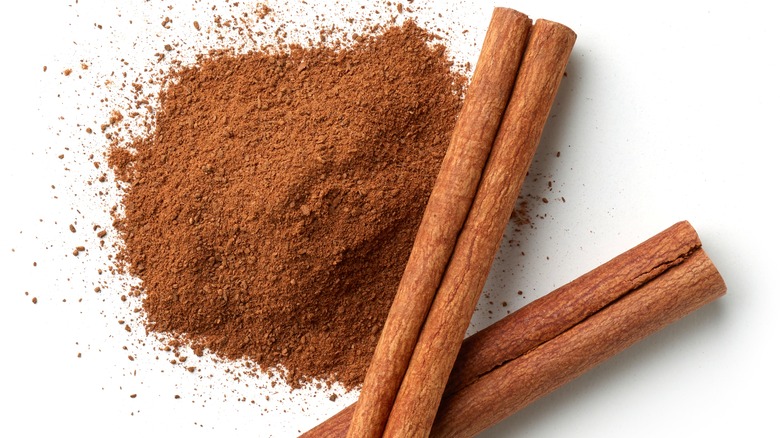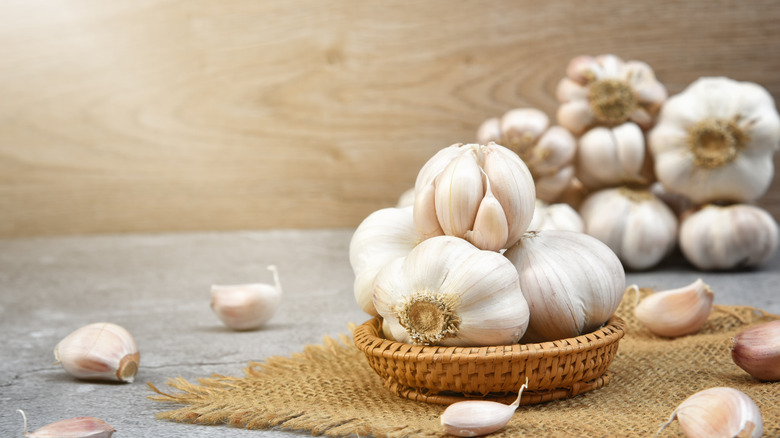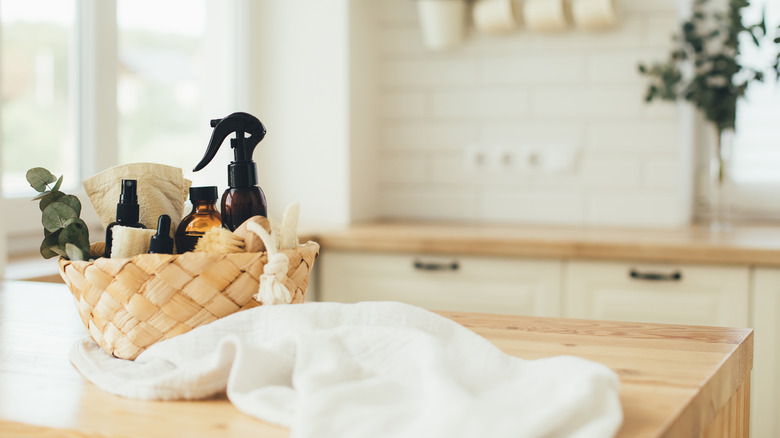How To Keep Bees Away With Items From Your Kitchen
With summer comes the flowers and, naturally, the pollinators. Hummingbirds and butterflies do important work to keep plants healthy and thriving as they flit elegantly from blossom to blossom. Bees perform similar chores to maintain our ecosystem, but with two significant downsides. They can become a nuisance as a swarm and even sting unsuspecting humans. Bee stings are painful and have the potential to cause severe reactions. According to the Mayo Clinic, those who are allergic to bee stings have a 25 to 65% chance of experiencing anaphylaxis, a quick and severe reaction that can be fatal. So, while these pollinators are happy guests to any garden in bloom, they may not be considered a welcome addition to your house's eaves or window ledges.
Pest management can be pricey as well as potentially harmful, if not toxic, to the other living beings around your home. The good news is that there is a slew of natural remedies to help keep unwanted bees away from structures and indoor areas without creating unnecessary harm to the environment. And many of them can already be found in your kitchen pantry.
Peppermint oil
For many of us, the smell of peppermint oil is refreshing and perhaps even delicious. But bees feel quite differently about this topical product, making it an excellent repellent. Since it is nontoxic to pets and children yet unappealing to the bees, peppermint oil is a no-brainer for use throughout your home or on yourself. As per Garden Guides, if you're heading outside for some yard work, you can try a few drops of oil on your skin or clothing. Take note that oils can damage or stain delicate fabrics, so do a test on a spot that won't be noticed first.
A few drops of peppermint oil mixed with a gallon of water can also be spritzed from a spray bottle. Outdoors, this spray can be used on the siding of your house and patio furniture. You can even spray down plants you don't want the bees perching on. As with fabrics, take care to ensure the leaves of your plants are not sensitive to the oil. Spritz a single leaf and wait to ensure there's no burning or other damage before spraying the entire plant. Peppermint plants can also be a great addition to kitchen windowsills, patios, porches, and decks. Grown in containers, these plants will do the repelling without regular spraying.
Cucumber peel
According to The Bee Man, who has been safely removing and relocating bees and their hives since 1977, cucumber peel is another form of natural bee repellent. The bee removal expert explains that the acidity in the peel is what deters them. Consider adding this healthy vegetable to the menu if you're planning to go on an outdoor picnic or enjoy dinner on your back patio or deck.
A dish as simple as a salad with fresh cucumber slices will please your guests while seeming utterly unappealing to nearby bees. You can also peel the cucumbers and spread the skins around the table or dining area. And, of course, the next time you're in the kitchen preparing vegetables for a meal, don't forget to save extra cucumber scraps for future use. Keep them sealed in the fridge until you're ready to use them at your next outdoor gathering.
Distilled vinegar
Would you believe that something as simple as distilled vinegar poured into a bowl and left out can actually work as a bee repellent? Per Tips Bulletin, the pungent smell of distilled vinegar will quickly alert the bees to fly the other way. When you place the bowls in areas where you would like to deter these pollinators, leave them uncovered to get the potent aromas into the air and refill them as necessary.
Another great tip from Tips Bulletin is to use distilled vinegar as a cleaner. It's much safer than harsh chemicals, but it's known to clean just as well. Washing outdoor furniture or lawn items with vinegar may seem like a silly idea, but humans will only smell the scent for a short time. As it dissipates, you won't be aware of it any longer. The bees, however, will continue to sense it and steer clear.
Cinnamon
This household staple on your spice rack can also come in handy in the fight to keep bees at bay. Both cinnamon sticks and sprinkled cinnamon powder have been shown to get rid of bees by convincing them to find a new place to call home. World Birds explains that all you must do is spread the cinnamon on or around a hive, but they also warn that the process may require more than one application due to strong winds, rainfall, and other elements. The jury is out whether cinnamon kills or temporarily paralyzes the bees, but more often than not, the colony simply relocates.
If you opt for this method, keep in mind that you will have to get close to the hive to spread enough cinnamon within its immediate vicinity for successful results. Remember that disturbing the bees can cause them to swarm and sting, so wear protective gear such as long shirts and pants, goggles, and gloves to keep yourself safe.
Garlic
Garlic is a staple found in most kitchen cabinets and refrigerators, and it also gives off a lingering scent that is sure to drive bees away. Freshly minced or in powder form, garlic works in much the same way as cinnamon. Per the folks at MyMove, spread garlic around a hive and sit back and watch as the bees head off in search of new digs.
However, unlike cinnamon, garlic powder is more likely to kill a bee when sprinkled directly on it, so be gentle and patient when it comes to application. The goal is to safely move the bees to a new location, not destroy the colony. If you don't mind being close to the pungent odor of garlic, you can crush a few cloves and soak them in a shallow bowl of water. Wherever you decide to sit outside, place that bowl on the ground or table near you, and you'll enjoy a bee-free afternoon.
Put it all together in a homemade bee repellent spray
Rather than spreading and sprinkling all of these kitchen staples around your home and yard individually, why not mix them to create your own bottle of bee repellent spray? Earth911, a group focused on showing us how to reduce our overall environmental impact, offers a recipe to do precisely that. They recommend a blend of Dr. Bronner's peppermint scented Pure-Castile liquid soap, peppermint oil, cinnamon, and cayenne pepper mixed with water. But there's no reason for you to refrain from stirring in some crushed garlic and cucumber peels.
Natural home remedies tend to be safer and cleaner than the commercial chemicals sold in stores. And creating your own bee repellent spray is a great summer project with kids because you won't be required to go anywhere near the hive. As they mix and blend ingredients in the kitchen, they will understand the vital role bees play in keeping the world flourishing while also learning how to safely, gently, and naturally repel them from specific areas. Keep the spray bottle close to the table when you're outdoors grilling with friends and family, and before you know it, your neighbors will be asking for the recipe.
